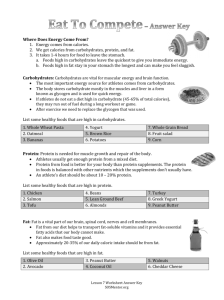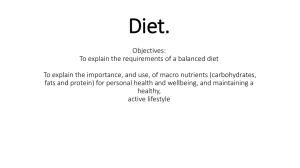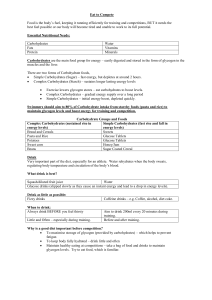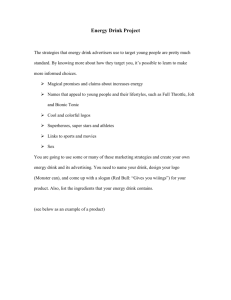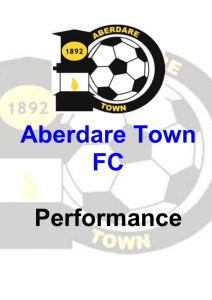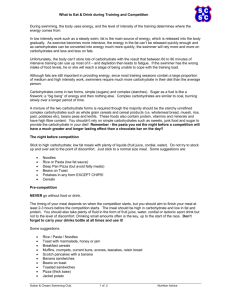soccer players and nutrition
advertisement
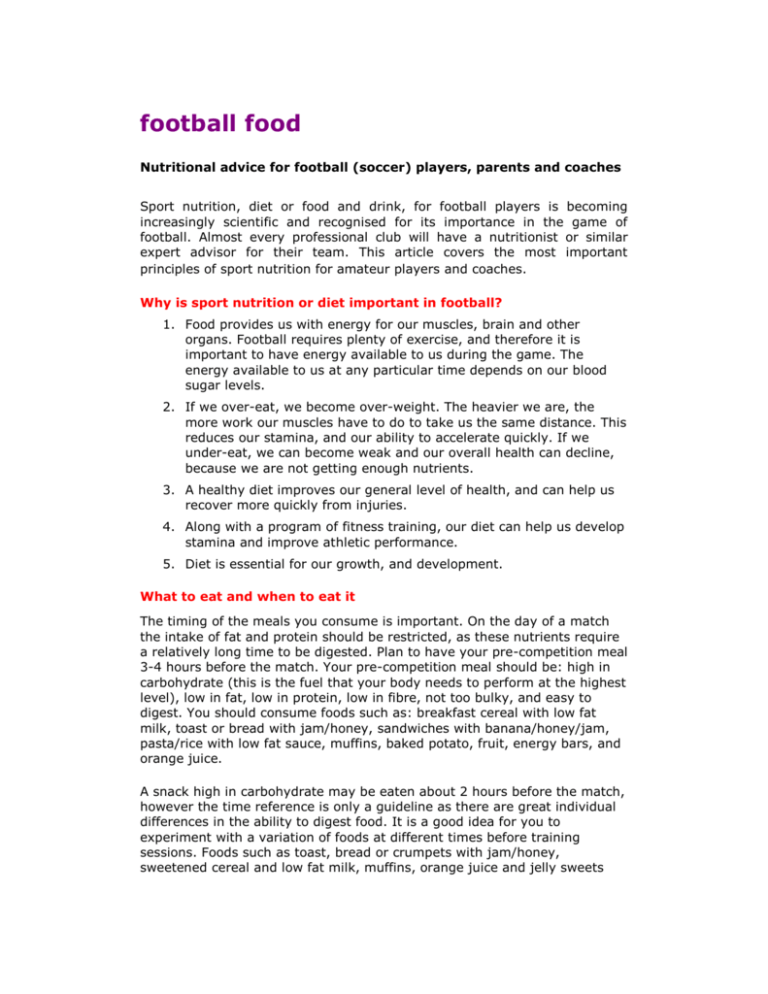
football food Nutritional advice for football (soccer) players, parents and coaches Sport nutrition, diet or food and drink, for football players is becoming increasingly scientific and recognised for its importance in the game of football. Almost every professional club will have a nutritionist or similar expert advisor for their team. This article covers the most important principles of sport nutrition for amateur players and coaches. Why is sport nutrition or diet important in football? 1. Food provides us with energy for our muscles, brain and other organs. Football requires plenty of exercise, and therefore it is important to have energy available to us during the game. The energy available to us at any particular time depends on our blood sugar levels. 2. If we over-eat, we become over-weight. The heavier we are, the more work our muscles have to do to take us the same distance. This reduces our stamina, and our ability to accelerate quickly. If we under-eat, we can become weak and our overall health can decline, because we are not getting enough nutrients. 3. A healthy diet improves our general level of health, and can help us recover more quickly from injuries. 4. Along with a program of fitness training, our diet can help us develop stamina and improve athletic performance. 5. Diet is essential for our growth, and development. What to eat and when to eat it The timing of the meals you consume is important. On the day of a match the intake of fat and protein should be restricted, as these nutrients require a relatively long time to be digested. Plan to have your pre-competition meal 3-4 hours before the match. Your pre-competition meal should be: high in carbohydrate (this is the fuel that your body needs to perform at the highest level), low in fat, low in protein, low in fibre, not too bulky, and easy to digest. You should consume foods such as: breakfast cereal with low fat milk, toast or bread with jam/honey, sandwiches with banana/honey/jam, pasta/rice with low fat sauce, muffins, baked potato, fruit, energy bars, and orange juice. A snack high in carbohydrate may be eaten about 2 hours before the match, however the time reference is only a guideline as there are great individual differences in the ability to digest food. It is a good idea for you to experiment with a variation of foods at different times before training sessions. Foods such as toast, bread or crumpets with jam/honey, sweetened cereal and low fat milk, muffins, orange juice and jelly sweets could be consumed. Once the game is over, fluids should be replaced and carbohydrate should be consumed as soon as possible to promote recovery of glycogen stores. During the cool down you should consume fluids and small snacks, such as jelly sweets, jaffa cakes and jammy dodgers. As soon as possible you should aim to consume a meal which is high in carbohydrates. Foods such as pasta, spaghetti, rice, noodles, low fat pasta sauce, bread, potatoes, and baked beans should be consumed during this period. Carbohydrate rich foods must be the main source of your diet. Table 1 lists foods, which contain a lot of carbohydrate. You should aim to consume the main bulk of your diet from complex carbohydrates. Simple carbohydrates should not be consumed in large quantities and are more useful as snacks between workouts, or to top up your energy intake. The carbohydrate you consume should be balanced with a healthy intake of protein, low fat and plenty of fruit and vegetables. Table 1 Carbohydrate-Rich Foods Complex Carbohydrates Simple Carbohydrates Mixture of Complex and Simple Carbohydrates Bread Sugar Cakes Pasta Jam Biscuits Rice Honey Puddings Noodles Yoghurt Sweet Pastries Oats Fromage Frais Cheesecake Breakfast Cereals (unsweetened) Ice Cream Breakfast Cereals (sweetened) Pulses (beans, lentils, peas) Jelly Bananas Baked Beans Raisins Grapes Apricots, Peaches Full sugar cordials Oranges Potatoes Jelly sweets Parsnips, sweetcorn Soft drinks (Lucozade, sprite, energy drinks) If you do not consume enough carbs (kcals/energy), then you will not have enough energy to complete the match (or training) and subsequently your performance will suffer, and more importantly you will be more susceptible to injury. Fluids We’ve done good food and we’ve looked at what snacks can boost the body during and after a match or training session. Now lets look at what you should drink. The water lost from the body during sweating needs to be replaced to stop you getting tired quickly, and also speed up the recovery process – that means feeling fitter and sharper afterwards a lot sooner. These checks will help players: * Weight – 1kg of weight lost during a training session is equal to 1 litre of fluid lost. * The ‘pee test’ – If your urine is dark coloured, it means you need to have a drink. Lots of trips to the toilet, producing lots of clear coloured urine, shows you’ve taken on enough fluid. * Thirst – Being thirsty is an unreliable indicator of when you need to have a drink. If you’re thirsty, you’re actually already partly dehydrated so if you finish a training session and you’re gasping it’s a giveaway you haven’t taken enough fluid on board. What's best to drink? For footballers, the best fluid to drink is a diluted carbohydrate/electrolyte solution. In plain English, that’s the kind of stuff you’ll find in stuff like Isostar, Lucozade Sport and Gatorade. When should I drink? Ideally, it’s best to drink before, during and after a training session, as well as drinking frequently during a match. How much should I drink? Only a little – but often. If you drink too much too quickly, you run the risk of getting a stomach upset. soccer players and nutrition - fact and fiction four common myths about food, drink and soccer players by Dr. Donald T. Kirkendall first published on USYouthSoccer.org There are more myths that coaches, players and parents may be following, but below four of the more common myths are dispelled. By following the nutritional guidelines below, players, coaches and teams can put themselves in an advantageous position before the match starts. Myth 1: Game performance is not affected by what you eat. Virtually every study on athletic performance for both team and individual sports shows that a diet rich in carbohydrates improves running performance. However, nutritional research from the 1970s to present day still show that soccer players choose a diet that is approximately 40 percent carbohydrates, 40 percent fat and 20 percent protein. What is discouraging is that in the very early 70s, the Swedes conducted a study that showed soccer players with low muscle fuel (glycogen) walk about 50 percent of the game. Even 30 years later, a study showed that more than half of a national team in the 1994 FIFA World Cup thought food had nothing to do with their performance. The bottom line is that players eat what is put in front of them. The more carbohydrates an athlete eats, the more endurance he or she will have. This means that when the end of the game approaches, the player will be able to run faster and longer if he or she consumed the proper amount of carbohydrates. Myth 2: What you eat after the game does not matter. At games and tournaments around the country, players will sometimes eat the worst post game snacks possible including soda, sweet drinks in soft packaging, potato chips, candy bars and fries. Everyone who has ever been to a soccer field on a weekend has seen this. Muscles are most ready to receive a fresh supply of fuel during the first hour or two directly following exercise. The smart coaches and parents supply food that will start refilling muscles with carbohydrates at just that time. A proper supply of carbohydrates is needed. It can come from a carbohydrate replenishment drink or other foods like bagels with jelly, pretzels, raisins or other dried fruit. This is even more critical between tournament games when the time between games is even shorter. Myth 3: A diet is good as long as an athlete gets enough protein. While most every survey of the athletic diet shows that players get all the protein they need from food, there is a problem. The vast majority of protein is consumed in conjunction with fat. Marbled meat, ground beef, and fried chicken all are examples of protein that is combined with lots of fat. Red meat should be trimmed of fat, and ground beef should be very lean. Chicken should have the skin removed before cooking. One place protein isn’t commonly found is the immediate post-exercise meal. A little protein helps in storing new fuel in the muscles faster than when there is no protein. Players can try to figure out a protein source after the game or drink a carbohydrate replenishment drink that contains protein. Myth 4: Your body is the best indicator of when to drink; Mother Nature knows best. For most mammals, it is OK not to drink until thirsty. However, the thirst mechanism of humans operates differently than the average mammal. In fact, the human thirst mechanism doesn’t even kick in until a person has lost about two percent of body weight from sweating. At this level, a decrease in performance begins to become evident. Players should drink before starting the game, every 15-20 minutes during play if possible, and at halftime. Make sure the team has drink bottles along both sidelines and in the goals so players have easy access to fluids during stoppages of play. Don’t forget that playing in the cold is also dehydrating, so drinking fluids is just as important in cold weather.

